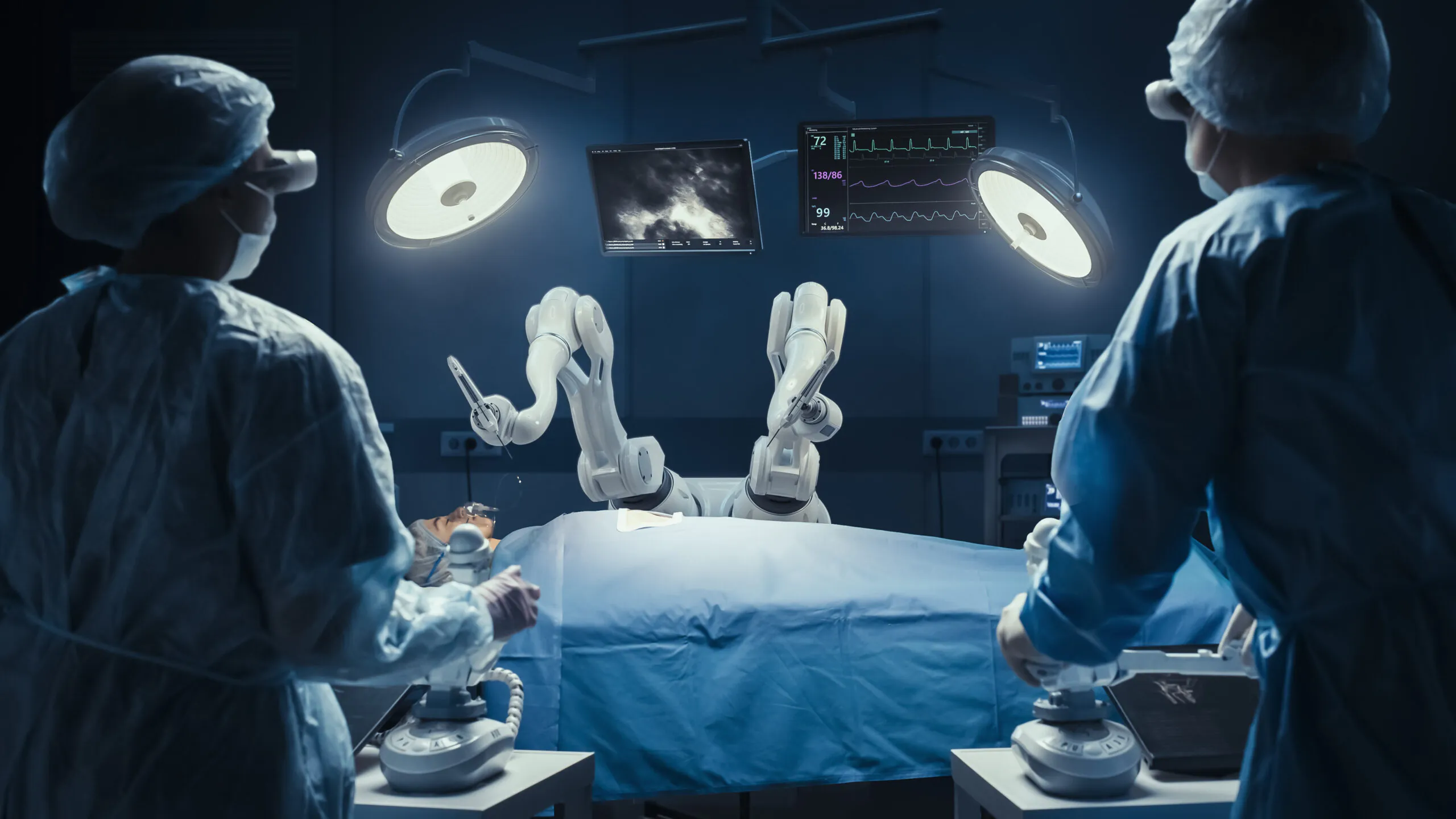Robotic surgery, also known as robot-assisted surgery, represents a groundbreaking advancement in medical technology, reshaping surgical procedures. It combines medical science, robotics, and engineering and is considered an evolution of minimally invasive surgery. During the procedure, surgeons use specialized robotic systems to enhance precision in complex operations, particularly in small anatomical spaces. This approach offers benefits such as tremor filtering, improved flexibility, and minimized involuntary inaccuracies, leading to fewer surgical complications, reduced pain, less blood loss, and quicker recovery times.
History
-
1980
Late 1980s - Early 1990s
Initial development of surgical robots for greater precision and minimally invasive techniques.
-
1990
Late 1990s:
Early systems like the Da Vinci Surgical System and the ZEUS Robotic Surgical System are developed.
-
2000
2000:
The FDA approves the Da Vinci Surgical System for general laparoscopic surgeries.
-
2000
Early 2000s:
Robotic surgery gains acceptance in various specialties, including urology, gynecology, and cardiac surgery.
-
2000
Mid-2000s - Present:
Further innovations focus on accuracy, integration with modern imaging, and a greater range of motion.
Examples of Robotic Surgical Systems
da Vinci Surgical System:
It is an ergonomically designed surgeon’s console, patient cart with four interactive robotic arms, high-performance vision system, and patented EndoWrist instruments. Itallows surgeons to operate from a seated position with a 3D view of the surgical area. Translates hand movements into precise actions of miniaturized instruments. The system offers precision, dexterity, and control with 1-2 cm incisions while minimizing unintended movements through tremor reduction.It is used in various procedures such as prostatectomy, hysterectomy, and cardiac surgeries.
Mako Robotic-Arm Assisted Technology:
It is designed for joint replacement surgeries (knee and hip). It utilizes a CT scan to create a 3D model for personalized surgical planning. It guides surgeons in removing diseased bone while protecting healthy tissue, ensuring accurate placement and alignment of implants for improved outcomes. The technology offers reduced pain, smaller incisions, less blood loss, and faster recovery compared to traditional methods.
Senhance Surgical System:
It is a robotic surgical system that enhances minimally invasive surgery through advanced technology. It provides tactile sensations to the surgeon, allowing for a more intuitive surgical experience and offers high-definition 3D imaging to improve visibility during procedures. Its modular design allows for easy upgrades and integration with existing surgical tools. It features advanced instrument control that mimics natural hand movements for enhanced precision. The system incorporates data analytics tools that allow surgeons to review performance metrics and improve techniques over time and is suitable for various surgical specialties, including gynecology, urology, and general surgery.
Benefits
Robotic surgery provides several benefits for both patients and surgeons.
Patients
Shorter hospital stays
Reduced pain and discomfort
Faster recovery times
Quicker return to normal activities
Surgeons
Enhanced visualization
Greater dexterity
Improved precision
The robotic system translates the surgeon’s movements into smaller, more precise actions, minimizing the risk of human error. Robotic arms can also access hard-to-reach areas inside the body with greater ease, enhancing the surgeon’s ability to perform complex procedures. Enhanced visualization, including a magnified, high-definition view of the surgical site, enables surgeons to identify and navigate delicate structures more accurately, reducing the likelihood of complications.
Challenges
Despite its advantages, robotic surgery faces several challenges. The cost of robotic systems, ranging from US$1 million to US$2.5 million per unit, and the additional disposable supply cost, which averages US$1,500 per procedure, make it more expensive. Extensive surgical training is also required to operate these systems effectively. Surgeons must complete 150 to 250 procedures to become proficient, and during this learning phase, operations can take longer than traditional surgery. Technical issues such as the lack of haptic feedback in some systems, where surgeons do not feel the interaction between the instrument and the tissue, also pose a challenge. The size and instrumentation limitations of robots, as well as issues with multi-quadrant surgery, also need to be addressed.
Future Trends
The future of robotic surgery is being shaped by technological advancements and evolving clinical needs. These trends enhance precision, efficiency, and patient outcomes, redefining surgical practice.
Key trends driving this growth include:
- Increased Automation: Expect increased automation in surgical procedures as AI and machine learning evolve. Robots will perform routine tasks autonomously, allowing surgeons to focus on more complex aspects, improving efficiency and reducing human error.
- Expansion of Applications: While primarily used in orthopedics and general surgery, applications are rapidly expanding into gynecology, neurosurgery, and even dental surgery. The versatility of robotic systems will allow them to be used in a wider range of procedures, benefiting more patients. Experts predict significant growth in general surgery, with many laparoscopic and open procedures soon to be performed robotically.
- Integration with Other Medical Technologies: Combining robotic systems with advanced imaging, AI-driven diagnostics, and real-time data analytics could create a holistic approach to surgery.
- Minimally Invasive Procedures: The rising demand for minimally invasive technology drives the robotic surgery devices market. Robotic surgeries reduce patient hospital stays, pain, complications, and recovery times.
- Growth in Orthopedic Applications: Robotic-assisted implant procedures are expected to grow, with companies adding shoulder features to their surgical robots. Outpatient large joint replacement is expected to continue growing in Ambulatory Surgery Centers (ASCs).
- Data Analytics and AI: Robotic equipment collects data for every patient case, which can be analyzed to find the best surgical methods. AI will use this data to improve practices and outcomes.
- Remote Surgery: Advancements are enabling long-distance remote surgery, with potential for use in space and remote areas.
Conclusion
Robotic surgery has significantly transformed modern medicine, offering enhanced precision, reduced recovery times, and other benefits for patients and surgeons. While challenges such as cost and the need for specialized training persist, ongoing advancements in technology promise to make robotic surgery even more vital in healthcare. As technology evolves, robotic surgery is expected to play an increasingly important role in surgical procedures, improving outcomes and bridging healthcare disparities.



